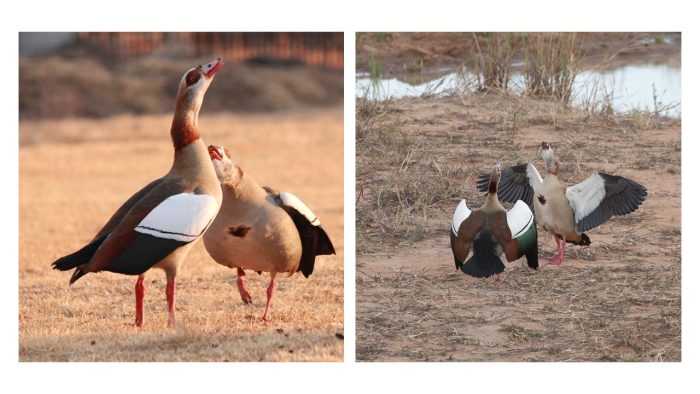Identification
The Egyptian Goose is not actually a goose, but a shelduck. It has many characteristics of a duck, but also some external traits of a goose. Egyptian Geese are easy to identify and can be found across a wide variety of habitats, including grass lawns, urban parks, artificial dams and school grounds.
It is a large brown to tan-coloured bird, easily distinguished from other geese and ducks by its large size, its reddish-brown eye patches and the reddish-brown patch in the middle of its tan-coloured chest (hence its Afrikaans name “kolgans”, meaning dot goose). Males and females look similar but the male is larger. The easiest way to distinguish between the two is on the basis of their call: males tend to mostly hiss, while the females mainly honk. Take a listen here.

Juvenile birds can vary in their colouration while their adult plumage (i.e., feathers) is still developing. They have dull brownish underparts and dark-brown to dull-brown colouration on their faces with no eye-patches.

Habitat
Egyptian Geese inhabit a wide range of freshwater habitats, including rivers, dams, marshes, lakes, reservoirs, estuaries, offshore islands and sewage works. They prefer bodies of water with open shorelines which are close to agricultural land or grasslands where they can graze for seeds, shoots, and other plant matter. They also feed on algae and aquatic plants, and the occasional worm, locust, or termite.

Distribution
They are widespread in sub-Saharan Africa as well as along the Nile River Valley. Substantial non-native populations have become established in the Netherlands, Belgium, Germany and the UK and appear to be expanding rapidly. Within southern Africa they are the most commonly encountered species of waterfowl and are found virtually everywhere, except in highly arid regions and at very high altitudes.
They prefer open habitats such as grasslands and agricultural fields, which is clearly visible in the SABAP2 distribution map. The dark blue areas (i.e., highest reporting rates) in the Western Cape contain large tracts of agricultural fields (mainly grain crops), and the blue areas in the east are mainly grasslands and agricultural land as well.

From bird ringing records, it is evident that Egyptian Geese are capable of widespread movements such as from the Western Cape to Namibia and from the Free State to Mozambique; dispersal distances typically range from 70 km to 800 km.
Behaviour
Egyptian Geese are commonly seen in pairs. They form strong pair bonds, and are often observed greeting their bond mates and performing a little courtship dance. Adults are fiercely protective of their young and will fearlessly attack potential predators.

Egyptian Geese are highly territorial, showing behaviours such as hissing, honking and chasing off rival birds. It can be quite entertaining to watch! Males sometimes get into fights with opposing males, trying to bite them on the neck while also beating them with their wings.
These birds can form large flocks where there is enough grazing available, such as on golf courses, agricultural fields and grasslands, and they are often observed among other waterbirds next to dams, rivers and wetlands.

During breeding, the nest is made by the female and consists of a shallow bowl of grass, reeds, leaves and down. The usual nest site is on the ground; the female first scrapes a shallow hollow in the ground before constructing the rest of the nest with plant material and down. However, nests are often also constructed on top of old nests of other species, such as Hamerkop, Sociable Weavers, crows, raptors, herons and cormorants. These may be found on cliff ledges, in and on buildings, and in tree holes.
Egg-laying season is year-round, peaking from May to December. The female lays 5-11 eggs, usually one per day, and on completion of the clutch she incubates them for 28-30 days before they hatch. During this time, the male spends most of his time perched nearby and guarding their territory. Both the male and the female feed and care for the chicks. The young fledge at about 60 to 75 days, remaining under the care of their parents for almost 4 months. The chicks reach maturity when they are 2 years old.


Further Resources
Species Text from the first Southern African Bird Atlas Project (SABAP1), 1997
Virtual Museum (BirdPix > Search VM > By Scientific or Common Name)
More common names: Kolgans (Afrikaans); Ilowe (Xhosa); iLongwe (Zulu); Lefaloa (North Sotho); Ouette d’Égypte (French); Nilgans (German).
List of bird species in this format is available here.
Recommended citation format: Daniel KA and Loftie-Eaton M 2022. Egyptian Goose Alopochen aegyptiaca. Bird Feeder Project. Biodiversity and Development Institute. Available Online at http://thebdi.org/2022/03/07/egyptian-goose-alopochen-aegyptiaca/


Hi there – the main juvenile pix doesn’t look right – would question if this is an Egyptian goose . Cheers Tess
Thank you Tess, I agree, I think it is a hybrid, will update the post accordingly 🙂 (Megan Loftie-Eaton)
Photo of juvenile has been updated 🙂